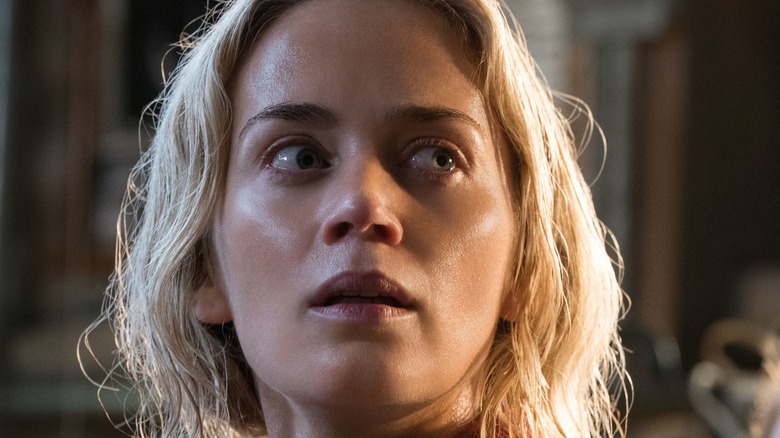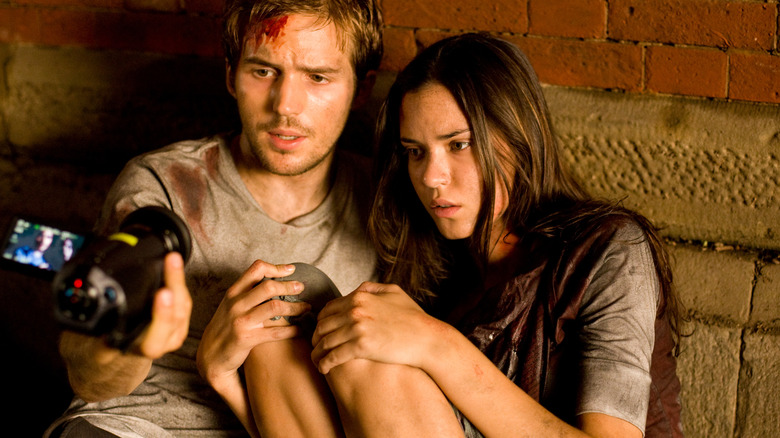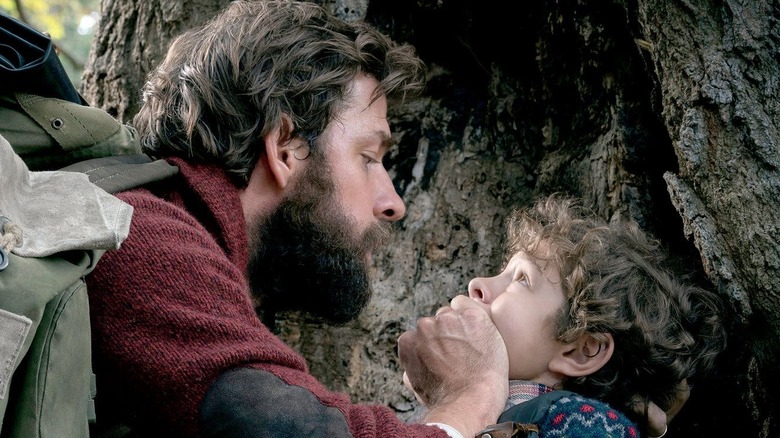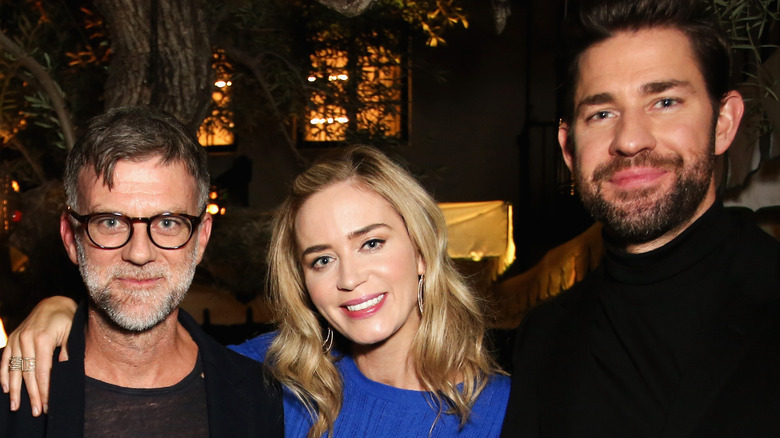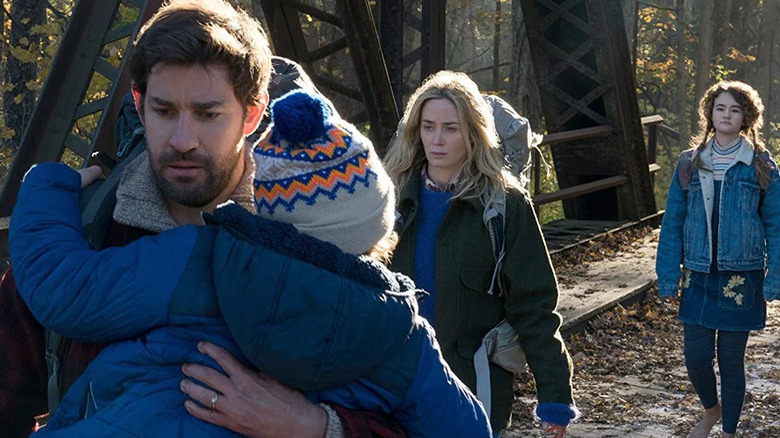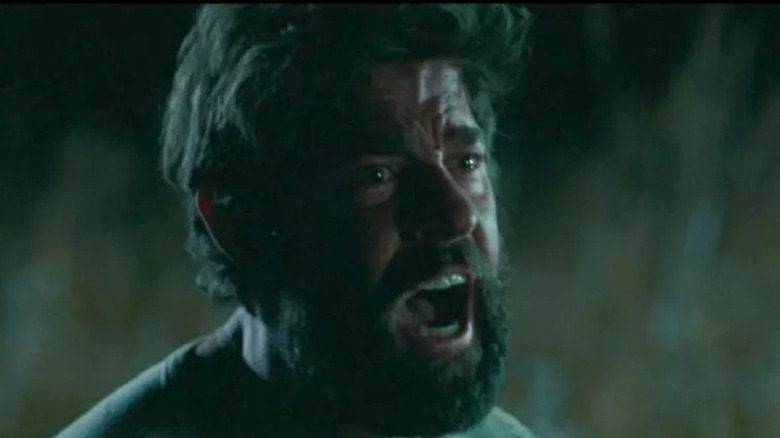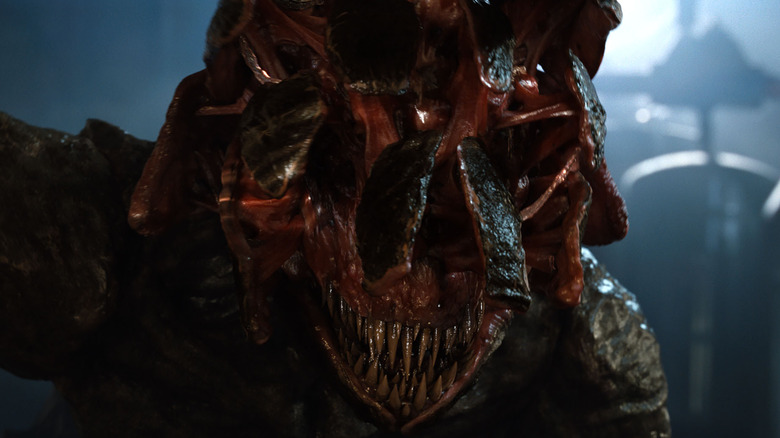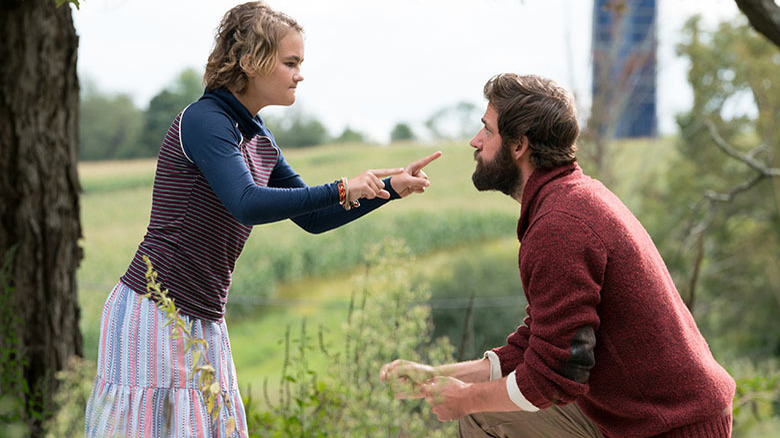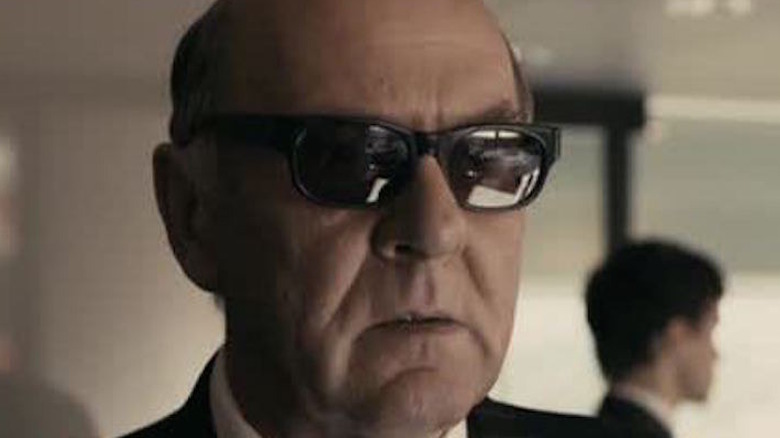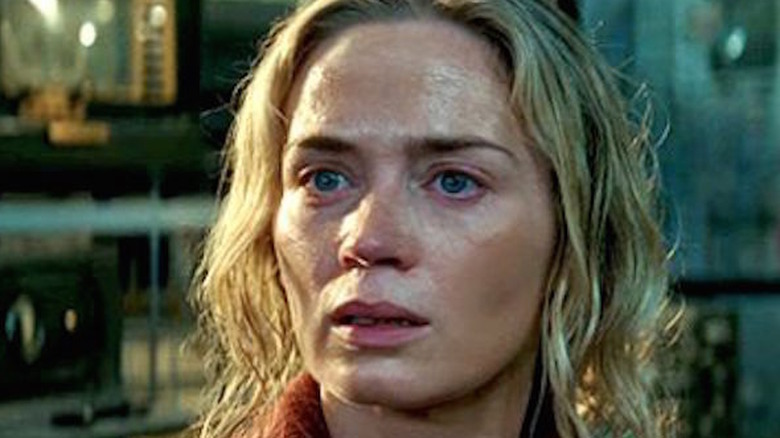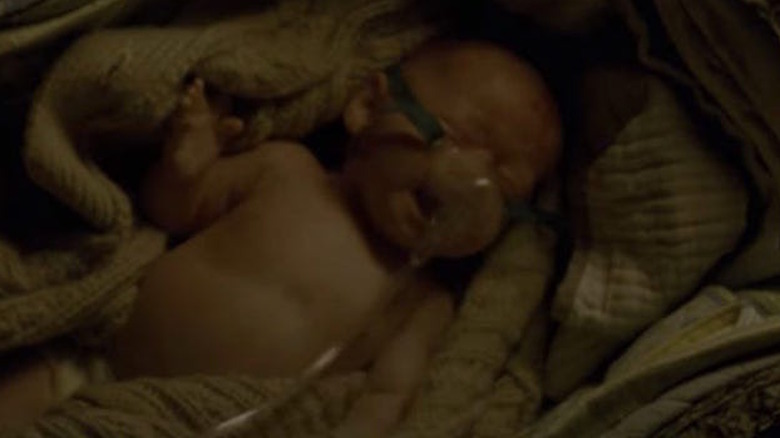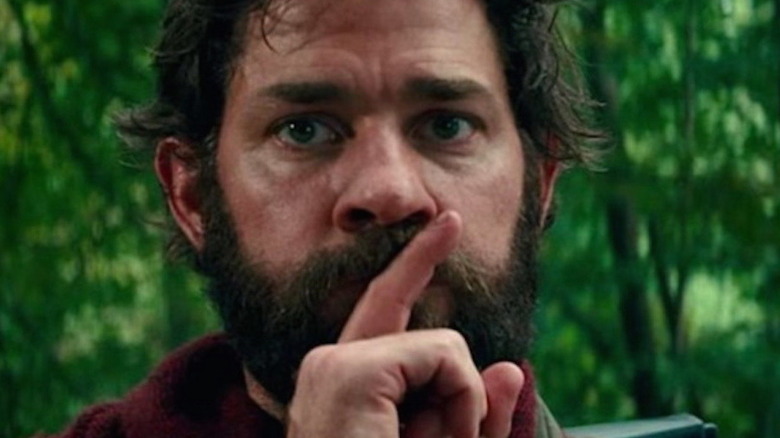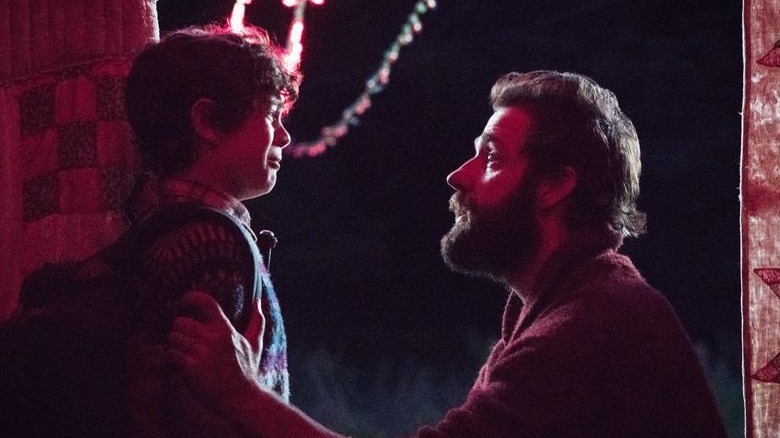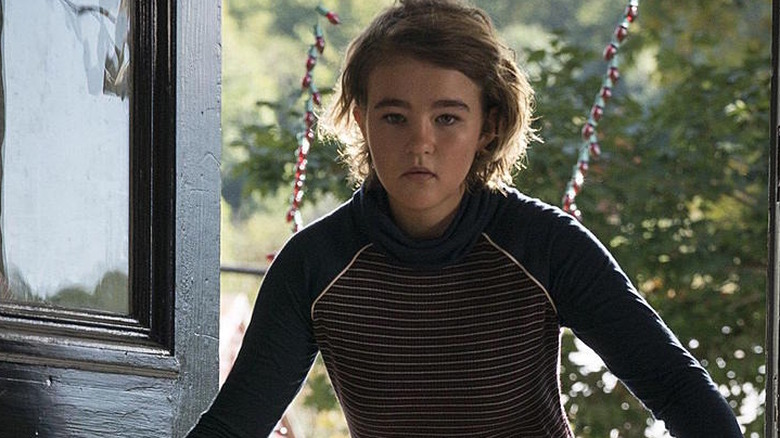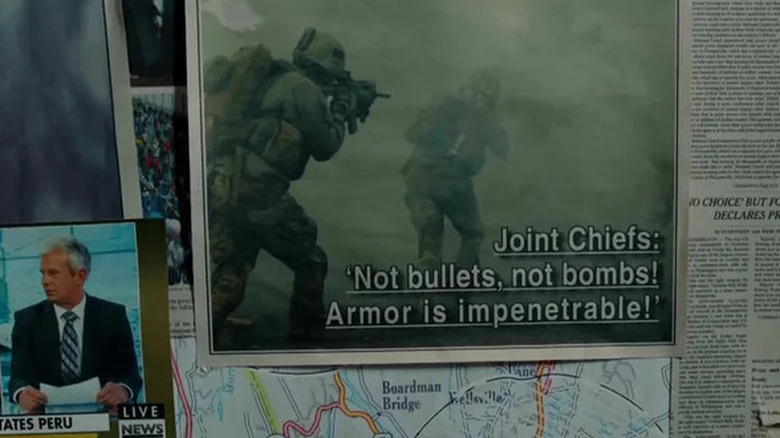A Quiet Place Facts We Can't Stay Quiet About
It's unlikely that anyone expected co-writer/director/star John Krasinski's 2018 horror film "A Quiet Place" to become the cultural phenomenon that it did. The Paramount Pictures release didn't come with much of a pedigree: Krasinski was best known as nice guy Jim Halpert on "The Office," and his previous feature directorial efforts ("Brief Encounters with Hideous Men" and "The Hollars") were minor indies and decidedly not horror films. But after a well-received screening at the South by Southwest film festival, "Quiet Place" went on to reap more than $341 million at the box office and numerous awards, including a Screen Actors Guild Award for Krasinski's co-star (and real-life spouse) Emily Blunt. A sequel followed in 2021, and a spin-off film and videogame are in production.
Audiences responded rapturously to Krasinski's carefully crafted mix of suspense thriller, creature feature, and family drama, and media and fans have since explored every angle of the film, from fine-grain details to overarching themes. However, there are still a surprising number of anecdotes about "A Quiet Place" that yield new and intriguing information. Below, a spoiler-heavy breakdown of "Quiet Place" facts you'll want to scream from the rooftops.
A Quiet Place was nearly a Cloverfield sequel
Though ultimately a runaway hit for Paramount, there was no such expectations when co-writers Bryan Woods and Scott Beck brought the idea for "A Quiet Place" to the studio. In fact, the pair initially considered pitching their script as a possible addition to Paramount's "Cloverfield" series. It's worth noting that neither "10 Cloverfield Place" nor "The Cloverfield Paradox" were originally conceived as sequels either.
In an interview with /Film, the writers said that they had discussed the possibility of folding "Quiet Place" into the "Cloverfield" universe with executives at Paramount and their representation. The idea wasn't without its risks; as Bryan noted, "One of our biggest fears was this getting swept up into some kind of franchise, or repurposed for something like that." Though fans of "Cloverfield" producer J.J. Abrams, the duo wanted to deliver a new and original idea with "A Quiet Place."
Ultimately, the studio felt the same way. "They never thought about branding it as a 'Cloverfield' film, I think in part because conceptually it was able to stand on its own," said Scott. "What was really incredible about the process that we feel very grateful for is the studio embraced this weird movie with no dialogue with open arms."
John Krasinski cut the film without any sound — twice
Sound is crucial to not only the premise of "A Quiet Place," but also to experiencing the movie itself. For director John Krasinski, the sound design for the picture granted him a whole new perspective on storytelling and filmmaking in general. "[Sound] can either be a toolset that will fix things, or it can be a magic kit where you blow the lid off and start concocting potions of sound," he told the New York Times.
Perhaps the greatest lesson he learned from sound was that its absence could support a film's core strengths. While working on the editing process, Krasinski asked his editor to mute all the sound, including dialogue and sound effects. Alfred Hitchcock would've been proud.
"I needed to be able to connect with these characters without anything else," he explained. He completed two full edits on the film in this manner, with only the actors' movements as his guide, and was surprised by what he discovered. "Even on silent, there was so much communication happening," he revealed. "That sounds super pretentious, but it's true."
Paul Thomas Anderson gave Krasinski valuable advice
In a 2019 interview, Krasinski mentioned that one of the many high points in the swell of acclaim that followed the release of "A Quiet Place" was an awards-season screening of the film hosted by Paul Thomas Anderson. Krasinski said that the Oscar-nominated filmmaker had been supportive throughout his career, and called him to praise the picture after seeing it for the first time. "He was so specific and so honest about the movie," said Krasinski. "We were talking like we were on an even playing field, and that tripped my wires."
As an example of Anderson's influence on his career, Krasinski cited a conversation the two had at his 30th birthday party. Krasinski mentioned to Anderson that he had seen a "very arty" movie and described it as not very good. Anderson later pulled Krasinski aside. "He said very quietly, 'Don't say that it's not a good movie. If it's not for you, that's fine, but in our business, we've all got to support each other." Anderson's words were more than just a gentle admonition, because as Krasinski recalled, "He said, 'You've got to support the big swing. If you put it out there that the movie's not good, they won't let us make more movies like that.'"
A Quiet Place had a very different opening scene
The opening scene of "A Quiet Place" lays out, in stark terms, the terrifying existence led by survivors of the monster attack. Towns are barren and in disrepair, and the Abbotts — Krasinski and Emily Blunt as parents Lee and Evelyn, and Millicent Simmonds, Noah Jupe, and Cade Woodward as their children Regan, Marcus, and Beau — must scavenge from meager remaining supplies in order to survive. But they must also be completely silent while doing it, or risk a terrible death, as evidenced by the fate of the youngest Abbott child, Beau.
The sequence is the only flashback in "A Quiet Place," but as producers Andrew Form and Brad Fuller told Yahoo Entertainment, the film nearly opened with a very different scene. The original script by Woods and Beck opened with a scene that took place in the days before the invasion, featuring a character who was ultimately exorcised entirely from the finished film. The scavenging sequence, and Beau's death, took place later in the story as a second flashback.
As Form explained to Yahoo, the pre-invasion flashback "was removed from the film once John took over as director and co-writer." It's unknown if this sequence was similar to the harrowing opening prologue in "A Quiet Place Part II," which also takes place prior to the alien invasion.
Test screenings drew more laughs than screams
For Krasinski, nerves forced him to keep his expectations low when it came to audience reaction to "A Quiet Place" during its world premiere.
"If people clapped, that would be really cool," he said of his expectations in 2018. "[Instead] people stood up and made the craziest noise... I'll never forget it because I looked at my wife and she was yelling, 'Oh, my God.' [But] I couldn't hear her because the [cheering] was so loud."
Viewers had a very different response to "Quiet Place" during at least one test screening prior to release. Producers Form and Fuller recall one ill-advised screening where audiences were shown a cut that had incomplete visual effects. Krasinski — in Vans sneakers, no less — had stood in for the monster in some scenes, and even wore the motion-capture suit in others. Suffice it to say, the sight of Jim Halpert pretending to be a killer alien creature made it hard to stay focused on the horror elements.
"As hard as you try to tell an audience, 'Please, we understand all the visual effects aren't in, but that will be the creature,' it's impossible," said Form. "Someone's gonna laugh, and it just kind of breaks everything." Krasinski says he left the screening thinking, "I've just made the worst greatest comedy."
Bats inspired the creatures' communication
One of the most disturbing elements about the creatures in "A Quiet Place" is the fact that while they are relentless hunters and savage killers, they do so without sight. The monsters, or "death angels," as they're dubbed by the press in the film, rely entirely on sound to find their quarry — which they apparently kill without consuming — and that requires those evading them to take extreme measures in order to avoid becoming their next victims.
A feature in the New York Times illustrated some of the problems faced by Krasinski and the production team when trying to bring these unusual beings to life. For example: If the creatures are blind, how are they able to able to swoop down and attack their victims with such deadly accuracy? Sound editors Ethan Van Der Ryn and Erik Aadahl ("Godzilla vs. Kong) found the answer in nature.
"We were inspired by the idea of using echolocation like bats do," said Van Der Ryn. "They have these vocal sonar signatures that they can send out into space and hear the reflections of the space around them."
Millicent Simmonds' ASL advice brought Krasinski to tears
Though "A Quiet Place" was the result of John Krasinski's direction and script rewrite and Bryan Woods and Scott Beck's original script, a member of the film's cast crafted two of its most significant emotional beats. In an interview with Metro US, Millicent Simmonds explained how she reworked two important interactions between her character, Regan (who is deaf) and her father, played by Krasinski.
Simmonds, who is deaf in real life, said she suggested a change to the conclusion of an argument between Regan and Lee. "When me and John have a fight as father and daughter in sign language early in the film, he was the most dominant character, and I was supposed to cower to his needs," she explained. But in conservation with Krasinski, Simmonds thought the scene would ring more true as a moment if Regan fought against her father's wishes. "He loved that idea," she recalled.
Simmonds also changed one of the most important sign language exchanges in the film. "In the end, when he signs, 'I love you,' I said I think he needs to say, 'I've always loved you.'" The slight change added greater depth to the characters' relationship, and also brought resolution to their earlier conflict. Krasinski's reaction was priceless: "When I suggested that, he cried," said Simmonds.
Guy Ritchie and crayfish inspired the aliens' attack
One of the most tantalizing mysteries of "A Quiet Place" for early audiences was the origins of its malevolent monsters. Though Krasinksi has clarified that they are extraterrestrial in origin — and underscored that point with the meteor crash in the beginning of "A Quiet Place II" — he discussed one source of inspiration in the interview for Empire's Spoiler Special podcast in 2018. The podcast has been removed from Empire's site, but Krasinski's comments are reprinted in text form on the site.
Krasinski envisioned his extraterrestrial creatures as an invasive species, one that quickly overwhelms and dominates its new environment. "They're a thinking alien creature, and for me, this idea of a predator, this idea of a parasite, this idea of something that is introduced into an ecosystem [was interesting]," he explained. Invasive species, such as the Asian carp, cane toad, and kudzu, overwhelm natural habitats across the globe and cause untold damage to both the environment and the area's economy.
According to Krasinski, he drew upon an idea from Guy Ritchie's 2008 UK crime film "RocknRolla," which he cited as one of his favorite movies. In the film, Tom Wilkinson plays a gangster who uses crayfish that live in the Thames River to dispose of those who cross him. Wilkinson explained that the crayfish were American in origin and devoured the local variety before developing an appetite for anything in its path. "That's what I mean," said Krasinski. "[It's] the introduction of something that can't be held back."
Emily Blunt: Krasinski's love letter comment is messed up
Krasinski has said on many occasions that he viewed "A Quiet Place" as an extended metaphor for parenthood.
As he told the Toronto Sun, "The line that kept going through my head when I was rewriting this was, 'What would you really do for your kids?'" According to the filmmaker, the extreme situation faced by the Abbotts was a way to examine how parents are pressed to summon hidden reserves of strength to provide for and protect their families. "Remember the urban legend of the mom picking up a car because her baby was under it?" he said. "Where did she get the strength? That stuff always stuck with me — when you're pushed to this other side, this non-cognizant version of who we are."
Krasinski doubled down on the family metaphor for "A Quiet Place" to MTV News. "I know it sounds insane, but this is my love letter to my kids," he said. When told about her husband's comment, Emily Blunt noted, "That's kind of messed up... Our children shouldn't even see this [movie] until they're at least 40."
The baby in the box scene was the hardest to shoot
Amidst all the monster attacks and prolonged, suspenseful sequences in "A Quiet Place," one brief moment proved especially disturbing for both moviegoers and the filmmakers alike. That's the scene in which Lee Abbott, having discovered that Evelyn has given birth, takes mother and child down to the soundproof basement; there, he ensures that the newborn won't attract the creatures with its crying by placing it in a wooden box outfitted with an oxygen mask.
For Krasinski, who has two daughters with Blunt, the scene left him rattled on a personal level. "That was the most intense thing I've ever done in my career," he told Empire's Spoiler Special podcast. "I didn't expect how viscerally I would respond."
Krasinski said that he first obtained permission from the baby's parents, and offered to use a prop instead of a real infant. However, the parents allowed him to use their child, and the scene was shot in two nerve-wracking takes. "[The box] was basically a puffy bed and there were holes everywhere for the baby to breathe," he recalled. "But the entire crew had a nervous breakdown on that scene."
Office creator Greg Daniels gave Krasinski invaluable advice
John Krasinski is not a fan of horror movies. As he told the CU Independent, a friend told him that he never expected him to direct a horror movie. "And I said, 'Yeah, I can't even watch scary movies,'" said Krasinski. The friend told him that his distance from horror was the key to the movie's success. "He said, 'Well, if you were trying to scare people, that's not a genuine intention. That's just manipulating people, but if you actually try to tell a story where scares are an added bonus, that's the key to it."
Krasinski added that his inspiration to focus on the family came in part from his best-known role as Jim Halpert on "The Office."
"I remember ["Office" creator] Greg Daniels telling me, 'Your job is not to deliver these lines funny. Your job is to deliver these lines, and if people think they're funny, that's up to them,'" he said to the CU Independent. As Krasinski discovered, focusing on telling the family's story heightened the tension and anxiety around those scenes. "I looked at it just like Greg said," he recalled. "I said, 'If I can make you fall in love with this family, then you'll be scared because you don't want anything to happen to them.' So I owe him a lot for that."
Noah Jupe worried that farting would attract monsters
As the co-writer and director of "A Quiet Place," Krasinski was the go-to for both cast and crew to answer any questions that came up during shooting. No question was too offbeat to answer, including a very personal but entirely honest query from Noah Jupe, who played the Abbotts' eldest son, Marcus. In an interview for the Empire Spoiler Special podcast, Krasinski said that Jupe asked him what his character would do in case of an accidental noise, such as a cough, sneeze, or — well, a fart.
As Krasinski recalled, he tried to give Jupe as straight an answer as possible. "I said, 'Well, you guys would know to pick up a pillow and cough into the pillow." As for the other bodily expressions, Krasinski said, "Just try to crop-dust. As long as they're not loud and violent, you're going to be fine." The director then took the scenario a step further: "I only imagine now little Noah putting a pillow on his behind and farting into a pillow, knowing that it would save his life," he said.
Millicent Simmonds' mother helped Krasinski understand her character
Krasinski's commitment to grounding the fantastic premise of "A Quiet Place" in as much real-life as possible was key to audiences forging an emotional connection with the Abbotts, which in turn boosted the tension when it came to scenes involving the monsters. When it came to depicting how Regan Abbott perceived the world as a deaf individual, Krasinski turned to her mother, Emily, to provide insight.
"We hadn't even thought of the idea of Millie's envelope," he told the Hollywood Reporter. By "envelope," Krasinski means the range of Simmonds' hearing, of which he was unaware until speaking with Emily. "Her mom said, 'Yes, she can actually [hear]. She can hear a car door behind her. She can hear a little bit of your voice when you're speaking, but not enough."
From there, Krasinski was determined to find a way to depict Regan's envelope, which he accomplished with the help of the sound editors. The effort was not lost on Simmonds' mother. "She said, 'I've always wondered what it would be like to be my daughter, and you finally delivered it for me,'" said Krasinski, who added that her comments reduced him to tears.
The New York Post loved its fake headline
Audiences are given precious little information about the invading aliens in "A Quiet Place." Much of what viewers come to understand about them can be ascertained via the few interactions between the Abbotts and the creatures in the wild, and from a visit to the basement of the family's home. There, Lee has gathered bits of information he's come to understand about the monsters — handily written out on a whiteboard — as well as clippings of newspaper coverage about their attacks. Among them is a headline from the New York Post that confirms what the viewers has come to understand about the "death angels": "IT'S SOUND."
When asked about the clipping, Krasinski told the Spoiler Special edition of the Empire Podcast that the venerable newspaper wasn't planning to okay any of the mock-up covers. "They didn't know what the movie was going to turn out to be," he noted. However, the headline featured in the movie won them over. "On that one — this is an amazing compliment — the editor of the New York Post said, 'Well, that's actually what we would have written.'"
